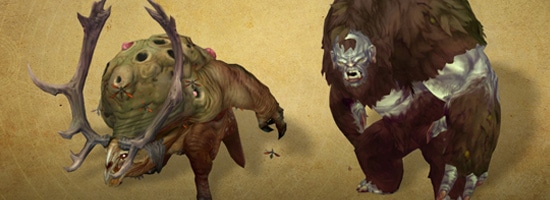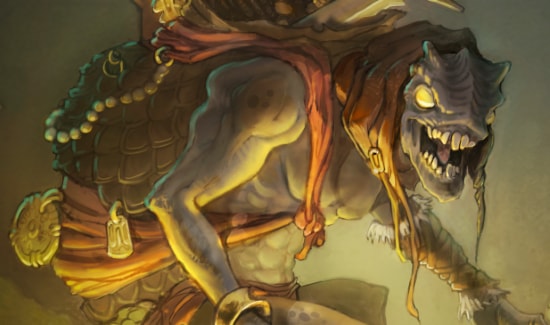Diablo 3 news » Developer Insights: Behind the Goblin Giggle
"Whee-hee!” It’s a natural reaction. The moment you hear that high-pitched, maniacal giggle, you have to track down its source. In an instant, you know by the sound of that mischievous squeal that untold treasures await. No matter the peril in your way, you will track it down and claim its hoard. That adrenaline rush all starts with a sound.
Sound design can too often go unrecognized. Every clang of a sword, rustle of foliage, and mystical hum of arcane power in Diablo III was carefully and lovingly crafted. In order to lend some insight as to how these auditory punctuations are put together, we want to share the story behind one of our most iconic sound-driven features: the Treasure Goblin.
The General Process
Behind every monster noise and combat clang, there’s a process. Ordinarily, teams like game design and art will place requests for sound design based on what the game needs. This might be anything from a Legendary power to a new monster and their combat noises. Then begins an experimentation process that’s become more gut instinct than step-by-step procedure for our experienced and well-oiled sound design team.
“We’ve built such trust over the years that we typically just start working on stuff,” Sound Design Supervisor Seph Lawrence says, fondly looking back on the twelve years of work he’s poured into Sanctuary. Different tasks get assigned out to the team of sound designers and each artist takes their own individual initiative to bring the game to life.
Approaches vary widely, but it always begins with taking a look at the clues the rest of the development team has provided. For example, when designing sounds for a monster, it’s best to start with other developed content like story and lore, concept art or 3D models, or combat abilities. In order to narrow in on what details might be needed, the sound team begins to ask questions like, “How big is it? What’s the creature made of? Is it fleshy or made of bone? Does it spew liquid? Is it a watery liquid or more like a goo? What’s its home environment like?” The inquiries can be endless, but sometimes, even they may not be enough, and the artist pulls from their imagination to fill in the blanks.

An enemy looks really different when you think about how it sounds.
From there, a designer can delve into either an exhaustive library of original sound effects to put something together or acquire recordings of relevant sounds. This can be accomplished either by reproducing sound effects in a recording setting, or voice-over for more vocalized needs. Most often, it is a combination of all three; manipulating, layering, and mixing them together to create something new, unique, and memorable.
On Goblins and Gold Piles
While this general process for sound design applies to most of the sounds you hear in Sanctuary, the Treasure Goblin proved to be an entirely different beast. How quickly and serendipitously his sounds came together is what truly makes him special.
The Treasure Goblin was a later addition to Diablo III. When the sound team was presented with his art, there was some trepidation in the need to tackle “yet another bi-pedal monster.” So they asked, “What makes him unique? What is the best detail to hone in on?” Ultimately, the trademark grin on every Goblin’s face revealed a conniving vibe.
The development team was eager to get a placeholder into the game, so Seph took to the recording booth to experiment. “I wasn’t trying to make the final stuff,” he swears, shrugging helplessly. “It just kind of ended up that way.” Through a series of laughs, guttural giggles, and playful exclamations, the core feel for the goblin came together quickly.
The sounds that Seph produced in the recording studio went over to Michael Johnson, who is now also a Sound Design Supervisor. He processed the raw audio, playing with tonality and pitching up Seph’s performance. Ordinarily, for a darker, more horror-oriented game like Diablo, this technique would be avoided as it has a tendency to produce a cartoony result. For some reason, this direction just worked for the Treasure Goblin and the rest of the development team loved it.
The Treasure Goblin was the result of a perfect storm made up of instinct, experimentation, and a lack of fear in the final product. The team didn’t get tied up in perfectionism; they entered the realm of improvisation and riffed until it just felt right. With the emotional response this little guy evokes before he’s even seen on screen, it’s hard to argue with the results.
Leaving Lasting Impressions
Diablo has a very unique sound to it. Senior Sound Designer David Rovin explains that the goal is to be darker and more organic overall. “We avoid things like delay echoes or things that sound particularly ‘sci-fi.’” That said, despite his comical nature, the Treasure Goblin surprisingly fit in well to this auditory aesthetic, introducing a brief moment of humor and whimsy to the otherwise bleak and dark tone of Sanctuary.
What’s your first reaction when you hear a Goblin giggle? Are there any other sounds in Diablo that give you a gut reaction? Tell us your favorites in the comments below and the next time you’re out running bounties or Rifts, open your ears and listen a little more closely to the sounds of Sanctuary.
















 Update comments
Update comments